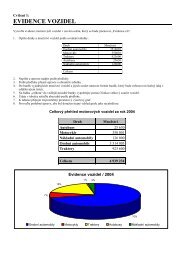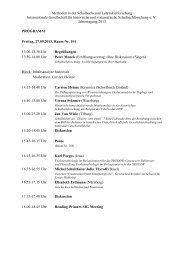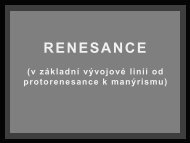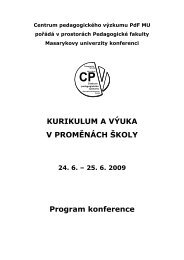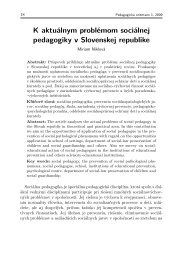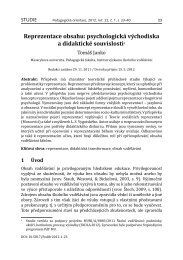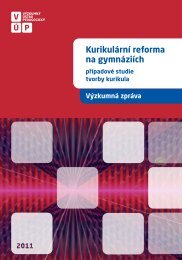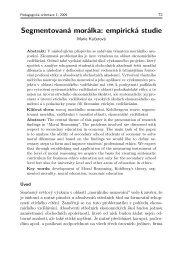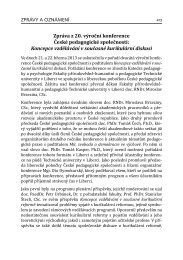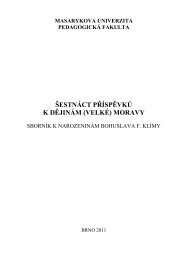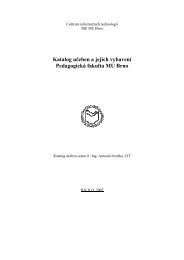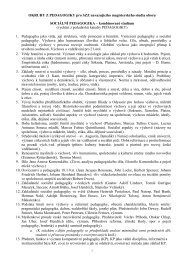SbornÃk pracà Pedagogické fakulty Masarykovy univerzity, Åada ...
SbornÃk pracà Pedagogické fakulty Masarykovy univerzity, Åada ...
SbornÃk pracà Pedagogické fakulty Masarykovy univerzity, Åada ...
You also want an ePaper? Increase the reach of your titles
YUMPU automatically turns print PDFs into web optimized ePapers that Google loves.
BOHUSLAV F. KLÍMA<br />
Summary<br />
The sources of drinking water in the settlement development of St. Hyppolitus fortification<br />
Presence of water has always been important for all human settlements. Therefore, archaeologists<br />
occasionally come across some objects and places that had been artificially made or adapted so that they<br />
could provide people with clean water. These places were interpreted / defined as wells, reservoirs or<br />
cisterns, etc. They come from different historical periods. The oldest documented ones come already from<br />
the old Neolithic period and were discovered e.g. in Mohelnice – in an old Neolithic agricultural settlement.<br />
The Celts could manage water very well in their oppida and finally the Romans, who built their manykilometres-long<br />
water supplies into their city centres.<br />
In the course of recent archaeological research in the Great Moravian upland fort of st. Hyppolitus in<br />
Znojmo, we managed to record and examine a few objects and find situations that must have had some<br />
connections with water supplying. The area of Hradiště has no water springs of its own on the rocky peak.<br />
Therefore, the locals were dependent on a few water resources. The first possibility was hard and painful<br />
water delivery from stream of Gránice or the river Dyje, the carriers, however, had to overcome steep<br />
slopes and hills within vertical interval of 120 metres with buckets full of water. The second alternative,<br />
which played a very important role especially in the times of danger or jeopardy /siege/ of a fortified centre,<br />
was digging / excavating of water cisterns directly on the territory of Hradiště. These reservoirs, however,<br />
cut in a hard seat rock, collected more often surface water only. We discovered one of these cisterns that<br />
showed a perfect regular boiler-shaped form near a group of a few houses of the German inhabitants<br />
coming from the younger Roman period in the south-eastern part of Hradiště. This object was later used<br />
by the Slavs in the 9 th century. The cistern, however, must have lost water in the end, therefore we found<br />
there skeletons of a dog and a bird, probably sacrifices – they were lying in the very centre of the bottom<br />
on a large flat stone / rock. Another cistern – excavated and widened and cleaned more times – was<br />
discovered on the square in the very centre of the settlement. It was 13 metres deep and was used as a well<br />
by the locals as late as until the beginning of the 20 th century. At its bottom, under a five-metre-thick layer<br />
of a sediment and mud was found a silver coin “denár” coming from the beginning of the 12 th century. This<br />
finding can show how old this cistern was. On the base of the location, the origin of this object being in the<br />
centre of the settlement, can be considered coming from the Great Moravian period.<br />
An easier and less painful way, how to get drinking water in Hradiště, was water delivery from the<br />
water springs existing still today in the western foreland of this centre; there was an easier access to the<br />
Great Moravian fort from that side. Late, this way became the main route for building a wooden and then<br />
ceramic water system whose founders were the local provosts of the Knights of the Cross with the Red Star<br />
in the 17 th and 18 th centuries. Even in the future, we are going to pay more attention to this very interesting<br />
subject of water in Hradiště near Znojmo.<br />
18




